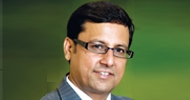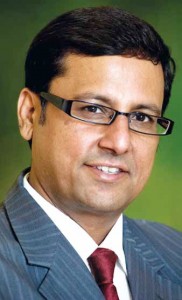
Vivek Sharma, General Manager and Business Head, Government and Defence Vertical, Wipro, spoke to eGov on various aspects of the e-Governance projects being launched in the country
 Tell us about the e-Governance projects that you are involved with at centre and state level.
Tell us about the e-Governance projects that you are involved with at centre and state level.
In India, e-Governance has taken great strides in the last four to five years, especially after the coming of the National e-Governance Plan (NeGP). We have had a fair amount of success in the e-Governance vertical across diverse government departments. Wipro has played important role in several large as well as medium sized projects in diverse areas of health, education, administration, services, applications, infrastructure, defence, security. We have been involved in UIDAI imitative, we have been part of e-district initiative and we have also had fair amount of success in infrastructure projects like the State Data Centres, which are coming up in many states across the country. In CCTNS project also we are playing an important role. Some of our e-Governance projects have already been executed; some of them are under execution. The largest e-Governance project that we have successfully executed is Employees’ State Insurance Corporation’s (ESIC) Project Panchdeep.
Tell us about your experience of executing the Project Panchdeep.
The Employee’s State Insurance Corporation (ESIC) has partnered with Wipro to establish a comprehensive and complex IT eco-system managing the delivery of medical care services for employees. It is the largest such social welfare scheme in the world. The project was worth approximately Rs. 1182 crores. It involved development of software applications and IT infrastructure that covers 2220 sites across India with large roll out of over 20 million biometric identity cards and a database of over 50 million fingerprints. So the Panchsheel has also led to the creation of one of the largest biometric databases outside the UIDAI scheme and the NPR. The project was divided into five broad categories. The first category was devoted to developing a system of confirming the identity of the various employees enrolled into the project. The second had to do with creation of IT infrastructure, things like data centres, storage facilities, security systems, etc. The third category of the work was one that involved development of a software that can cater to the functioning of the entire healthcare segment. Then there were the insurance applications. And finally, there was the aspect of networking all the 2220 locations so that we had a broad framework of networked locations.
What is your response to the e-Governance policy that is currently active in the country? Tell us about your expectations from the government.
Given the size and the complexity of some of the e-Governance projects, it is necessary that there has to be a substantial amount of commitment from both sides. In case of Project Panchdeep, we had commitment of all the stakeholders for making the project operational in time. The government was very clear about the targets that had to be achieved while executing the project. There was clarity about the first milestone that had to be achieved. From our perspective we would like to see a better coordination between the centre and the states to decide how the e-Governance services get finally rolled out in the country.

What new trends in e-Governance are you witnessing?
With the advent of National e-Governance Plan (NeGP) and Mission Mode Projects, the e-Governance sector has received a huge fillip. Before this we were only having department based initiatives for computerisation, etc. But now we are having e-Governance solutions that are being provided on a much larger scale, their focus is to not just improve the functioning of a particular department. Rather, the e-Governance projects being planned currently are focussed on improving the quality of governance in general and bringing about seminal improvements in quality of people’s lives. Now the idea of having anytime, anywhere services online from the government have become very popular with the net savvy generation. So e-Governance is an idea whose time has come. Purely from a technological standpoint, the biggest trend in e-Governance is that now there is increased reliance on cloud based solutions.
Benefits from Employees’ State Insurance Corporation’s (ESIC ) Project Panchdeep :

• More than 60 million IPs and their families are availing medical services at any ESIC facility across India
• Daily count of patients being treated using the system across ESI locations—75,000+
• As each claimant was issued two smart cards (one for himself and one for his family), it became easier to access medical services even if the insured person (IP) was at another location, thereby saving time and effort.
• The national-level CDR provides for better quality of clinical care anytime anywhere.
• Wipro’s automated services resulted in greater efficiencies with lower turnaround time and faster claims processing
• Reduced operational costs and redundancies as a result of better inventory
management
• Automated and improved resulted in fewer errors and increased employee productivity by reducing redundant data entry and processes
• The online system reveals the complete list of the IPs to employers for a simplified method for calculating contributions and payments.
• Better flow of information/ approvals through the online workflow as compared to the conventional system, which needed the physical transfer of files across India.
When it comes to e-Governance,what is your dream project?
It is very difficult to say what a dream e-Governance project would be like. The field of e-Governance is so vast that there is so much that can be considered from a perspective of what can be done and what cannot be done. We are having e-Governance projects in fields of education, healthcare, administration, infrastructure, defence, security, etc. The overall aim of e-Governance is to bring better benefits to the people; hence a dream e-Governance project would be one that can bring maximum amount of benefits to the people. Actually there cannot be a single dream project; there can be series of dream projects for many different verticals.
Wipro’s solution comprises of the following
• A biometric basedidentification system for IP by providing them with identity cards, ensuring that subscribers (IP) receive their medical and other benefits.
• A Unified Information System automating all internal and external processes connected with ESIC .
• Core insurance application for contribution (revenue) management
• Medical Information system for hospitals and dispensaries used by doctors, nurses, pharmacists, medical technical staff and administrators.
• Enterprise Resource Planningenhancing productivity of ESIC employees running finance, HRMS, Payroll, materials management, library management
• An end-to-end solution for project management (PMD)
• A statistical and enterprise intelligence system enabled high data analytics capability for improved decision-making
• State-of-art voice and videoconferencing equipment for ESIC offices making it a future ready workplace.
• Wipro networked 2220 locations
• An Enterprise Management System for managing system performance and SLA monitoring
• A centralised data and disaster recovery center with hardware such as servers, storage, security and network devices ensuring an integrated and secure information retrieval system.
• Alternate power mechanisms at branch offices and dispensaries ensuring maximum up-time.
• Change Management leading to speedier adaption of IT by the users
• Countrywide user and admin training for ESIC staff and users of the medical and ERP systems
• Maintenance and support for all software and hardware for a period of five years through its Facility Management Services, centralized help desk and onsite support.
Be a part of Elets Collaborative Initiatives. Join Us for Upcoming Events and explore business opportunities. Like us on Facebook , connect with us on LinkedIn and follow us on Twitter, Instagram.











